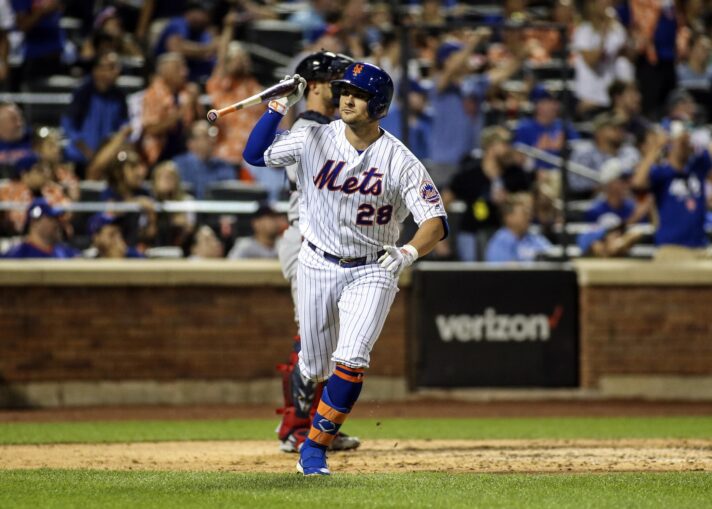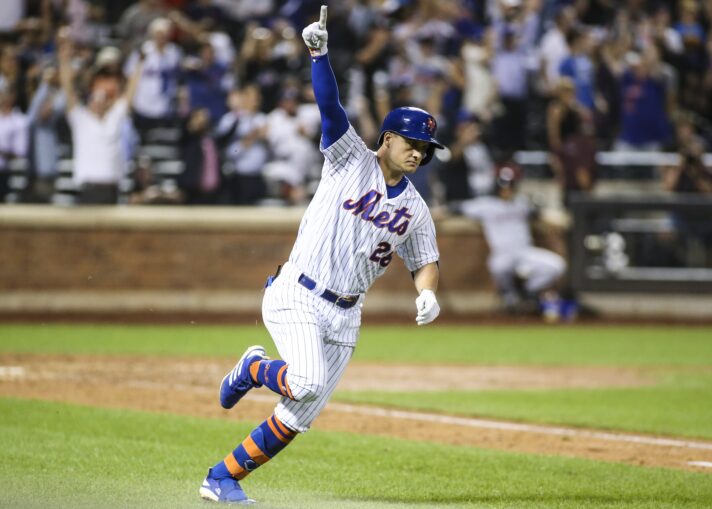
As the season approaches its final month, the gap between the Mets’ performance against weaker competition and “real” competition (basically most NL teams with a winning record) prompts consideration as to how that gap might be bridged.
As Brodie Van Wagenen’s first off-season in the GM chair has shown, the likelihood of multiple moves involving valuable assets seems high, One of those assets could be J.D. Davis, whose breakout performance at the plate combined with his youth and controllability should make him an attractive bargaining chip.
Undoubtedly some will question why the Mets wouldn’t choose to retain him for just those very reasons. The answer becomes clear when envisioning a likely 2020 lineup with certain roster constraints taken into consideration.
The two primary constraints will come in the form of Yoenis Cespedes and Robinson Cano whose contracts -barring a highly unlikely swap for players who come with a similar financial burden-basically demand their presence on the field.
Not that the prospect of that pair’s availability as legitimate lineup components presents a less-than-desirable scenario – it’s just that the idea that either or both will maintain their health and performance throughout the majority of next season is one best regarded as wishful thinking.
Nevertheless, I fully expect the organization to take the approach that Cespedes and Cano will be penciled in to next year’s lineup in left field and second base respectively, likely pushing Jeff McNeil to third where his glove and bat will provide a more than reasonable replacement for the departing Todd Frazier and leaving Davis and Jed Lowrie (when and if he comes back) without a position.
While it is possible that the team could look to retain Davis on the roster and employ him in utility role and bat off the bench, it would seem that one could anticipate sufficient demand for him on the open market as a regular to net a return that could address a more pressing need on the part of the Mets.
Those particular needs have become glaringly obvious in the course of the current season regardless of the winning streaks that have served to salvage what looked to be a lost campaign.
They are: the bullpen, which has largely remained an ongoing quagmire of crapshoots despite the emergence of stalwarts such as Seth Lugo; the bench, which will probably be depleted by the loss of Dominic Smith – another valuable trade chip; and the upper minors which have become a storehouse of four-A talent and some genuinely useful fringe veterans looking for a final hurrah.
If dealing Davis and Smith can serve to address at least two of these concerns, the current rotation and the return of Cespedes and Cano to at least part-time effectiveness (along with the hoped-for restoration of Brandon Nimmo to his 2019 level of production) should serve to place the 2020 Mets squarely in contention for a post-season berth.
Naturally, other possibilities for tweaking next year’s roster could surely alter this scenario (e.g. dealing Wilson Ramos back to the AL where his dependable right-handed bat and ability to serve as a backup catcher would prove more valuable and signing Yasmani Grandal), but unless a trading partner is found that could accommodate either Cespedes or Cano, the 2020 alignment projected by the current state of the Mets’ roster looks to be the most logical outcome.
If this proves to be the case and Cespedes can provide 75-80% of the production he delivered during the time he managed to be on the field since arriving in New York, and if Cano can provide at least a smidgen above league-average production from his slot, this wouldn’t necessarily be a bad thing.
The major concern would be having sufficient backup to their positions to cope with what seems to be an almost inevitable requirement for time on the IL for the two of them. Given Van Wagenen’s apparent ability to find reasonably effective support at both the major league level and Triple-A, a plan like this would appear to have the potential for providing enough talent to field a winning lineup.
When J.D. Davis was obtained in January from Houston for three prospects, I wasn’t familiar with him and was intrigued by the fact that he had won a PCL batting title in 2018.
His performance this season has done much to suggest having some faith in Van Wagenen’s trade judgment in light of the potential disaster of the Edwin Diaz and Robinson Cano deal for a package including Jarred Kelenic and Justin Dunn. Nevertheless, his emergence as a definitively bat-first utility player suggests his future lies in the AL.
If he ultimately winds up providing enough offense to provide some thrills for the 2019 squad and enough trade value to bring back effective reinforcements for 2020, then the deal that netted him will prove to be one of Brodie’s more canny moves.















